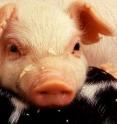Veterinary scientists track the origin of a deadly emerging pig virus in the United States
Veterinary researchers at the Virginia-Maryland Regional College of Veterinary Medicine at Virginia Tech have helped identify the origin and possible evolution of an emerging swine virus with high mortality rates that has already spread to at least 17 states. A team of researchers led by Dr. X.J. Meng, University Distinguished Professor of Molecular Virology, has used virus strains isolated from the ongoing outbreaks in Minnesota and Iowa to trace the likely origin of the emergent porcine epidemic diarrhea virus (PEDV) to a strain from the Anhui province in China. The virus, which causes a high mortality rate in piglets, was first recognized in the United States in May of this year.
"The virus typically only affects nursery pigs and has many similarities with transmissible gastroenteritis virus of swine," said Meng, who is a faculty member in the Department of Biomedical Sciences and Pathobiology. "There is currently no vaccine against porcine epidemic diarrhea virus in the United States. Although some vaccines are in use in Asia, we do not know whether they would work against the U.S. strains of the virus."
The researchers determined not only that the three U.S. strains of the porcine epidemic diarrhea virus are most closely related to the Chinese strains of the virus, but also that the U.S. strains likely diverged two or three years ago following an outbreak of a particularly virulent strain in China.
They published their findings on the "Origin, Evolution, and Genotyping of Emergent Porcine Epidemic Diarrhea Virus Strains in the United States" abstract in the Oct. 15 issue of the American Academy of Microbiology's journal, mBio.
According to the study, the U.S. strains of the virus share 99.5 percent of their genetic code with their Chinese counterpart. Allan Dickerman, a co-author of the paper and research assistant professor at the Virginia Bioinformatics Institute, performed the molecular clock analysis to determine that the divergence of the U.S. and Chinese virus strains coincides with a porcine epidemic diarrhea virus outbreak in China back in December of 2010.
Meng said it is unclear whether the U.S. strains of the virus diverged in China or in the United States.
The sudden emergence of porcine epidemic diarrhea virus, which belongs to the coronavirus family, has caused economic and public health concerns in the United States.
"The ongoing outbreaks of Middle East respiratory syndrome coronavirus in humans from countries in or near the Arabian Peninsula and the historical deadly nature of the 2002 outbreaks of severe acute respiratory syndrome coronavirus create further anxiety about the emergency of PEDV in the United States due to the lack of scientific information about the origin and evolution of this emerging coronavirus," wrote Dr. Yao-Wei Huang, the first author of the paper and a former research assistant professor at the veterinary college who is now a professor at Zhejiang University in Hangzhou, China.
Researchers have found no evidence that the virus can spread to humans or pose a threat to food safety. They did, however, come across additional evidence that the U.S. strains share several genetic features with a bat coronavirus -- findings which point to an evolutionary origin from bats and the potential for cross-species transmission.
Though commonly accepted that the virus spreads through the fecal-oral route, Meng said that scientists have not yet ruled out the possibility of other transmission routes. Symptoms include acute vomiting, anorexia, and watery diarrhea with high mortality rates in pigs less than 10 days old.
"Veterinarians need to recognize the symptoms of the disease, and with the lack of a vaccine in the United States, practicing strict biosecurity and good sanitation procedures on the farm are important for prevention and control of this deadly disease," Meng added.
Source: Virginia Tech (Virginia Polytechnic Institute and State University)
Other sources
- Veterinary Scientists Track the Origin of a Deadly Emerging Pig Virus in the United Statesfrom Science DailyTue, 22 Oct 2013, 19:30:17 UTC
- Veterinary scientists track the origin of a deadly emerging pig virus in the United Statesfrom PhysorgTue, 22 Oct 2013, 11:30:28 UTC
